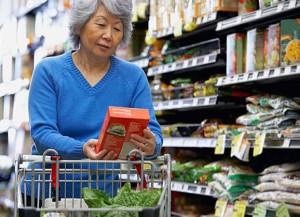Food Labels: How Bad Brands Happen to Good People
 With more than 20,000 food items lining the aisles of the local grocery store, odds are you have been suckered into buying foods and beverages that appear to be good for you but are actually detrimental to your diet, your wallet? and even your health. Welcome to the world of label trickery where marketing buzzwords like “fortified” and “sugar-free” trick millions of well-intentioned shoppers into reaching for Healthy Food Imposters.
With more than 20,000 food items lining the aisles of the local grocery store, odds are you have been suckered into buying foods and beverages that appear to be good for you but are actually detrimental to your diet, your wallet? and even your health. Welcome to the world of label trickery where marketing buzzwords like “fortified” and “sugar-free” trick millions of well-intentioned shoppers into reaching for Healthy Food Imposters.
You know what we’re talking about. Those pesky imposters that use front label trickery to insinuate that their brands are healthy but they actually have hidden trans fats and high amounts of sodium, preservatives, and artificial sweeteners and flavorings. They are anything but healthy. How many times have you fallen prey to these front label tricks that pop up on many of the most-popular brand name foods?
“Fortified”, “enriched”, “added”, “extra”, and “plus” usually mean the food has been altered or processed in some way.
“Zero trans fat” implies that a product has no trans fats; but labeling law loopholes allow foods that contain less than 0.5 g per serving to declare ZERO! Beware: Code words for trans fats include hydrogenated or partially hydrogenated oils.
“Light,” or “Reduced Calorie” juices are usually watered down, contain far less juice, and have artificial sweeteners and chemical additives. Your best bet: Stick with 100% juice, while simply cutting the serving in half and adding a few ounces of water to save on calories.
“Made with wheat,” or “rye,” or “multi-grains” imply that it’s a good source of whole grains, but unfortunately, don’t tell you how much whole grain is actually in the product. Look for the word “whole” before the grain to ensure that you are actually getting a 100% whole-grain product.
“Natural” or “made from natural” simply means the manufacturer started with a natural source. Once processed, the food may not resemble anything “natural.”
“Organically grown,” “organic,” “pesticide-free,” and “no artificial ingredients” say very little about the nutritional value or safety of the product. Trust only those labels that say “certified organically grown.”
“Sugar-free,” “sugarless,” or “no added sugar” tells you nothing about sugar derivatives or sugar substitutes, which can yield just as many calories as table sugar and may be more harmful to you than sugar.
Reality Check: To avoid being tricked by misleading label claims by following these three easy steps:
Step One: Speed read the front label! Remember, manufacturers use this prime real estate to entice shoppers to buy their products. Translation: Much of the wording is pure advertising jargon.
Step Two: Go to the ingredients list! This is where they tell you what’s in the food. Manufacturers list ingredients in order from most to least. Next, look for words that you can’t pronounce or terms that sound like something from your ninth-grade chemistry textbook. This is yet another clue that there are chemical additives that might be harmful to your health.
Step Three: Quick-scan the Nutrition Facts label, this is where you’ll find the amounts of nutrients you’re getting based on the ingredients list.
Taken together, this information will help you make the healthiest brand choices. More importantly, it will help you avoid those pesky imposters. Leave them on the shelf right where they belong!

